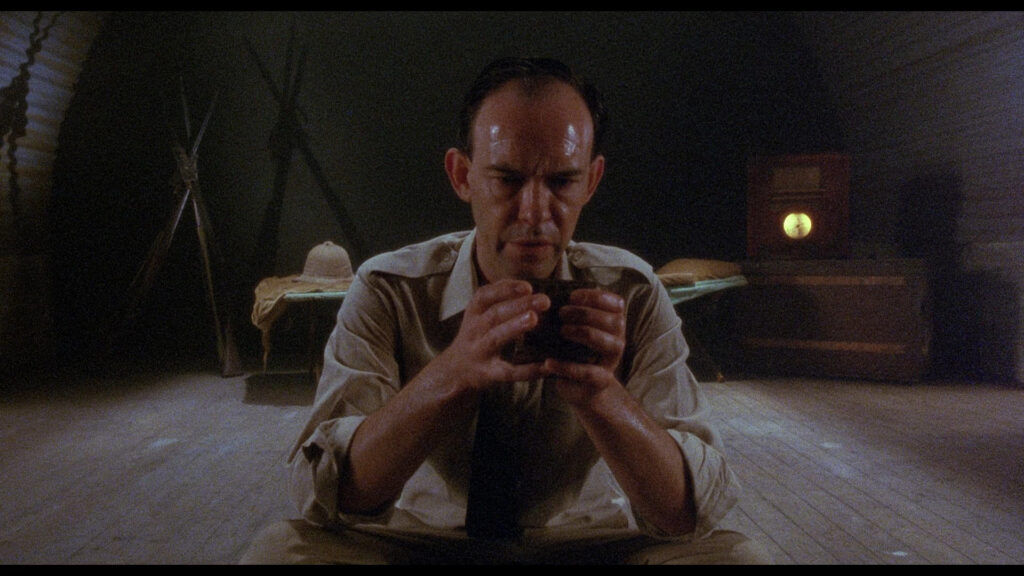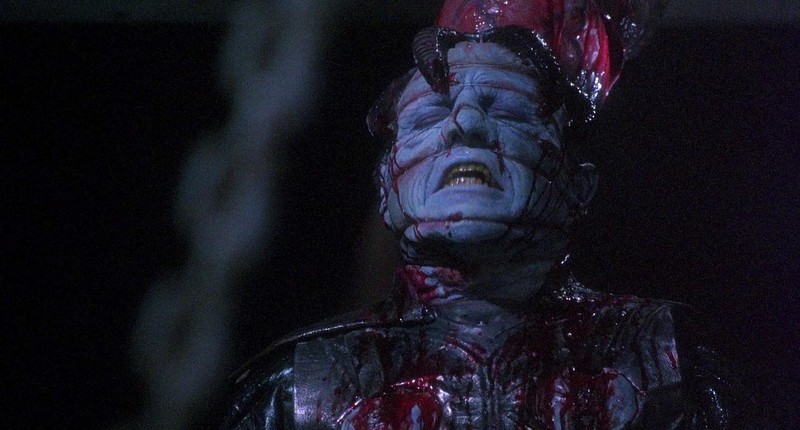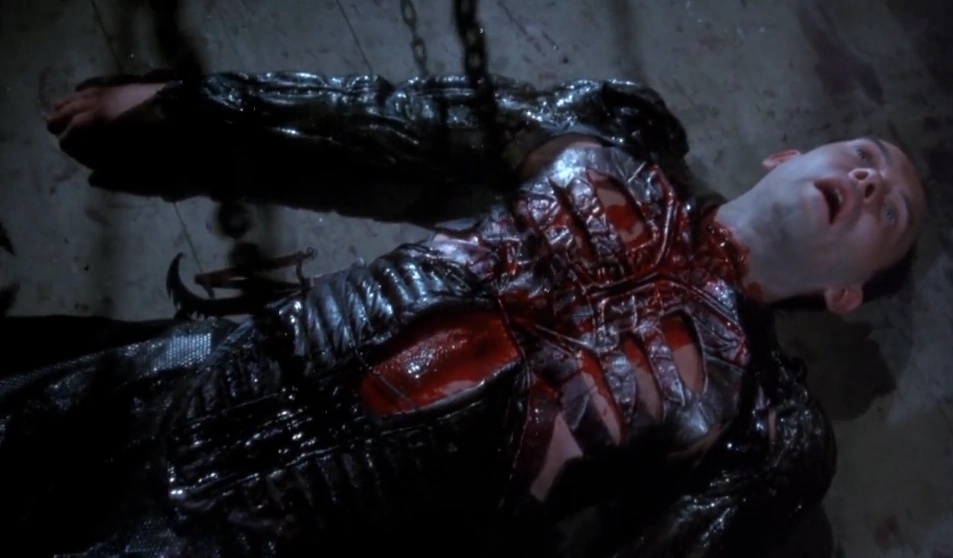Screenplay by: Peter Atkins, from a story by Clive Barker
Directed by: Tony Randel
Hellraiser II has at its core some glorious ideas to advance the original Hellraiser into its own expanded universe.
We see, for reasons that are referenced later in the film, the creation of Pinhead, which is something that fans of the original movie were intensely curious about.
We get confirmation that the Cenobites themselves were all once human “explorers in the realms of sensation,” rather than – as they now think of themselves – eternal creatures of Hell.
And we take that idea one significant stage further, with the creation (and eventual defeat) of a brand new Cenobite, in the person of Kenneth Cranham’s Dr Channard, who has a system set up almost guaranteed to eventually succeed and bring him the Cenobite gift.
So far, so excellent.

Cranham in particular is a joy in the movie – he has a talent for concealed malevolence that is shown to its full effect in Hellbound, although in fairness, it’s not particularly concealed for very long.
Channard has everything you could possibly need to become a Cenobite. He has his own “hell” of a mental institution, where he performs brain surgery like something out of the Victorian era. He has a traumatised mute teenager with an obsessive aptitude for puzzle-solving. And he has – which is a new development – a heck of a lot of LeMarchand puzzle boxes, of the kind which open portals to other dimensions, including the Hell dimension of the Cenobites.
That hints at whole worlds and histories of Cenobite action and sensual explorers that we’ve never encountered, and from there, the fan-fiction in our heads practically writes itself.
When he gains both Kirsty, her LeMarchand box, and the bloodstained mattress on which Claire Higgins’ Julia is said to have died in the first movie, he seems finally to have found the final pieces he needs to go on his own journey into the realms of agony.
Of course, it’s possibly worth mentioning that Julia didn’t die on any bloodstained mattress – she was stabbed to death on a staircase, but while this might seem like quite a hefty basis for quibbling, let’s for the moment let it go, or we’ll never get anywhere.

The Trouble With Hellbound
The “trouble” with Hellbound, such as it is, feels twofold.
On the one hand, there’s almost too much of a hangover from the first film here. The movie begins with a precis of the first movie, which – certainly if you’re bought the Quartet of Torment box set almost 40 years on from the release of the original movies, you could probably do without.
Frank is back, without much by way of explanation of how he leaves Kirsty notes in blood to come and get “him” – knowing she’ll assume it’s her father who needs rescuing. He’s in this movie mostly to motivate Kirsty, and to meet his final final end.
Julia’s back too, having her own turn at the “bloody musculature that needs bodies to rebuild it” game, but going through the process a lot faster than Frank in Hellraiser, given Channard’s ready-made charnel house of victims to feed her.
But what’s more jarring is that while she’s been gone, she appears to have made a deal with a higher power, Leviathan, to bring souls to feed it (which are to be turned into Cenobites). While there’s some storytelling chops in that, and it works to add a whole new element of depth to the Hellraiser universe, making Julia almost a new version of the vagrant who has previously passed on the LeMarchand box to interested sensual explorers, it feels like it comes out of virtually nowhere when it’s revealed, so your brain takes a while to adjust to her new status.
While Ashley Laurence as Kirsty Cotton was a traditional fairy tale princess in Hellraiser, with the screen presence of a stunned mullet, here she develops some grit the more she works out what’s going on. That’s a positive development, but, much as the Nightmare on Elm Street movies would continually develop the next heroine in line, as Kirsty grows up, the mute puzzle-solving teen, Tiffany (no, really), takes up her duties as characterless plot-driver, giving Imogen Boorman little to do but play with puzzle boxes and occasionally scream and gibber.
Dude, Where’s My Philosophy?
On the other hand, Hellbound is a much less philosophically interesting movie than its predecessor, and goes in for very much more gore-splatter to fill in the gaps in its sense of purpose. That’s particularly the case in the resurrection of Julia, in which a patient of Channard’s who believes he’s crawling with bugs is let loose with a straight razor and hacks himself to death on the mattress to promote her original rise from the grave. But it’s also there in some of the Hellscapes through which Kirsty and Tiffany wander – circus jugglers who on closer inspection are juggling the spongy eyeballs from their own empty, bleeding sockets, babies sewing up their own mouths, and other such outre elements.
The resolution of the plot, such as it is, has an air of inadvertant hilarity about it, with great vistas of a Hell dimension being very big to very little effect, an almost comedically convenient slip and fall leading to a dangle from a building for extra jeopardy, and a gratuitous and odd bit of skin-wearing along the way.
That means it’s significantly less emotionally satisfying in its ending, and has to have a tagged-on sequence of the mattress (which, again, Julia didn’t die on) claiming an innocent victim, and spawning our old friend the spinning column of body parts at the end to clumsily suggest we’ll be back with more box-opening fun for a third instalment.
But the Cenobites, though…
One thing though that Hellbound definitely delivers is more interest in the Cenobites. From the early sequence of Pinhead’s creation, to the apparent slaughter of the Cenobites we’ve come to know and wait for by Channard’s new kid in town, and their reversion to their human forms in the moment of their death, to the idea of Leviathan creating new Cenobites out of the souls brought to it, it helps us delve into an evolving mythos and makes us wonder about that wider world of Cenobites and explorers.
There’s also an interesting, if rapidly dismissed, caveat about the bad idea that is “I think I’ll open a LeMarchand box.” When Tiffany opens our familiar box, and the Female Cenobite (Grace Kirby replaced in this outing by the gloriously appropriately named Barbie Wilde) starts sharpening her instruments of torture, Pinhead reminds her that it’s not the hands that open the box that summon the Cenobites, but the desire to explore their gifts.
Which would be fine in and of itself, if both Pinhead and the Female Cenobite didn’t then, almost immediately, torment Kirsty with the idea that even though she opened the box innocently on both occasions, they’re beginning to suspect she’s just toying with them, and her protection from them is wearing thin.
But one of the most interesting elements about this “humanization” of the Cenobites is that while it dilutes the element that most made them stand above other Eighties and Nineties slasher villains (the fact that they were implacably Hellish, rather than human), it also makes them significantly more interesting, like serial killers who were once curious children. Indeed, at the very end, we see Pinhead’s face on the spinning torture block, and it reinforces the idea that before they became these implacable Hell-beings, they suffered for their explorations, their experimentations and their curiosity.
Cranham’s Channard Cenobite, all tentacular badness and weak medical puns, has a very telling line the first time he emerges as a Cenobite – “And to think… I hesitated.”
That may be how the Cenobites we know and love feel about their pain and their duty now, but the idea that they, like all their victims, screamed when they were first caught by the box, makes them ever more interesting, particularly after we’ve seen their human forms.
Death of a Cenobite?
And while we get the idea from the ending that Pinhead will, in some form or other, be back, we’re left uncertain whether Cenobites can actually die if they’re attacked by other Cenobites.
The end result of all of which is a movie that has some intensely interesting elements, relatively drowned in schlocky scares, and serving a plot which all but unravels some significant time before reaching its end.

But should you watch it? And in particular, should you lay out hard-earned cash for it in the Quartet of Torment box set?
Well, yes. Firstly, however barking mad the plot, the movie’s never going to look or sound better than it does here (at least unless someone re-engineers the movie with significantly better CGI – which really would have made this box set a priceless investment).
And secondly, when it comes to extras, it would be difficult to imagine anything beating the Quartet of Torment set. We’ll need a whole extra article to run you through even a handful of them, but there’s everything from new appreciations of Clive Barker’s writing to examinations of various elements of the Hellraiser mythos and appeal, from the LeMarchand boxes to the fetish scene, to body horror and transcendence. Interviews both archive and newly discovered are here too, and – as you’d expect from a horror franchise so intrinsically visual-driven as Hellraiser is – the whole package looks so superb, you’ll invite people round to your house just to look at it on your shelf, whether they’re fans of the films or not.
Hellbound may be a lot messier than the original Hellraiser, but if you can pick through the schlock and the Scream Queen necessities of a bigger and broader sequel, there are diamonds of flesh to be gleaned from it still, over 30 years on. And quite apart from anything else, if you don’t watch Hellbound, then Hellraiser III: Hell on Earth is going to mystify the wiggins out of you. For that, as much as to largely put the original Larry/Julia/Frank/Kirsty storyline properly to bed, Hellbound is a hugely necessary addition to the storyline of what will become the whole Hellraiser universe.



Be the first to comment on "Hellraiser – Quartet of Torment: Hellbound – Hellraiser II"